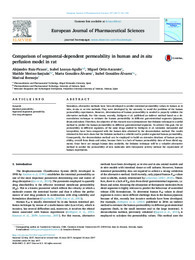Please use this identifier to cite or link to this item:
https://hdl.handle.net/11000/35158Full metadata record
| DC Field | Value | Language |
|---|---|---|
| dc.contributor.author | Ruiz Picazo, Alejandro | - |
| dc.contributor.author | Lozoya-Agullo, Isabel | - |
| dc.contributor.author | Ortiz-Azcarate, Miguel | - |
| dc.contributor.author | Merino-Sanjuán, Matilde | - |
| dc.contributor.author | González-Álvareza, Marta | - |
| dc.contributor.author | González-Álvarez, Isabel | - |
| dc.contributor.other | Departamentos de la UMH::Ingeniería | es_ES |
| dc.date.accessioned | 2025-01-22T12:15:48Z | - |
| dc.date.available | 2025-01-22T12:15:48Z | - |
| dc.date.created | 2017-06 | - |
| dc.identifier.citation | European Journal of Pharmaceutical Sciences 107 (2017) 191-196 | es_ES |
| dc.identifier.issn | 0928-0987 | - |
| dc.identifier.uri | https://hdl.handle.net/11000/35158 | - |
| dc.description.abstract | Nowadays, alternative methods have been developed to predict intestinal permeability values in human as in vitro, in situ or ex vivo methods. They were developed by the necessity to avoid the problems of the human permeability experiments. However, determination of human permeability is needed to properly validate the alternative methods. For this reason, recently, Dahlgren et al. published an indirect method based on a deconvolution technique to estimate the human permeability in different gastrointestinal segments (jejunum, ileum and colon). Therefore, the objective of this research was to demonstrate that Doluisio technique is a useful method to predict the human permeability in different gastrointestinal segments. To achieve this goal, the rat permeability in different segments, of the same drugs studied by Dahlgren et al. (atenolol, metoprolol and ketoprofen), have been compared with the human data obtained by the deconvolution method. The results obtained in this work show that the Doluisio method is a reliable tool to predict segmental human permeability. Consequently, the deconvolution method can be employed to build an extensive database of human permeability, overall from ileum and colon, because there is a lack of human permeability data of these distal segments. Once there are enough human data available, the Doluisio technique will be a valuable alternative method to predict the permeability of new molecules with therapeutic activity without the requirement of human experiments. | es_ES |
| dc.format | application/pdf | es_ES |
| dc.format.extent | 6 | es_ES |
| dc.language.iso | eng | es_ES |
| dc.publisher | Elsevier | es_ES |
| dc.rights | info:eu-repo/semantics/openAccess | es_ES |
| dc.rights | Attribution-NonCommercial-NoDerivatives 4.0 Internacional | * |
| dc.rights.uri | http://creativecommons.org/licenses/by-nc-nd/4.0/ | * |
| dc.subject | Intestinal permeability | es_ES |
| dc.subject | Segmental-dependent permeability | es_ES |
| dc.subject | Oral drug absorption | es_ES |
| dc.subject.other | CDU::6 - Ciencias aplicadas::62 - Ingeniería. Tecnología | es_ES |
| dc.title | Comparison of segmental-dependent permeability in human and in situ perfusion model in rat | es_ES |
| dc.type | info:eu-repo/semantics/article | es_ES |
| dc.relation.publisherversion | http://dx.doi.org/10.1016/j.ejps.2017.06.033 | es_ES |

View/Open:
10 Comparison of segmental dependent permeability in human and in situ (1).pdf
605,26 kB
Adobe PDF
Share:
.png)
